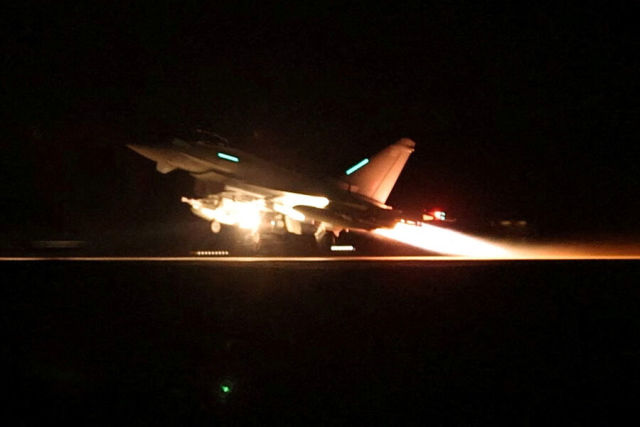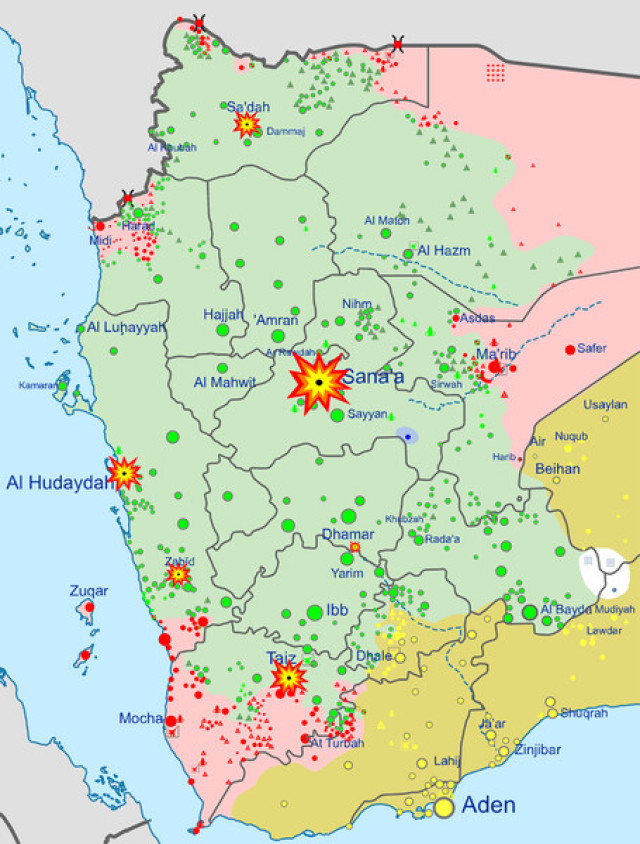Colonel Khodarenok: Biden will seek the complete defeat of the Houthis
On the night of January 12, the United States and its allies launched missile and air strikes against Houthi targets in Yemen. This was in response to the group's attacks on merchant ships in the Red Sea, the Gulf of Aden and the Bab el-Mandeb Strait. The military observer of the Newspaper analyzed how the conflict will develop further.En" Mikhail Khodarenok.
The situation in the region
Recently, the Houthis have carried out 27 attacks on merchant ships from more than 50 countries around the world. A kind of last straw that overwhelmed the patience of the United States was the attack of the Yemeni rebel movement Ansar Allah (Houthis) on a US Navy ship on January 9, 2024.
Currently, an aircraft carrier strike group (AUG) of the American Navy is deployed in the Gulf of Aden as part of the nuclear aircraft carrier USS Dwight D. Eisenhower (CVN-69), guided missile destroyers USS Carney (DDG-64, 90 Mk41-type ATVs, vertical launch devices for missiles of various classes), USS Laboon (DDG-58) and the USS Thomas Hudner (DDG-116), as well as the Ohio-class nuclear submarine (USS Florida, SSGN-728, can take 124 Tomahawk cruise missiles on board) and the Los Angeles-class multipurpose nuclear submarine (the ship's name has not yet been established). AUG actions are supported by several support vessels.
In addition, there is another US Navy aircraft carrier strike group in the Eastern Mediterranean, consisting of the aircraft carrier USS Gerald R. Ford and five escort ships, as well as the headquarters ship USS Mount Whitney, from which all forces and means in the region are controlled and interacted with. Vice Admiral Thomas Ishi, Commander of the 6th Fleet of the US Navy, is also on board Mount Whitney.
Finally, the destroyer HMS Diamond (D34) of the Royal Navy of Great Britain and the multi-purpose frigate Languedoc of the French Navy (D653) are stationed in the Red Sea.
According to a joint statement released by the White House by the governments of Australia, Bahrain, Canada, Denmark, Germany, the Netherlands, New Zealand, the Republic of Korea, Britain and the United States, ten countries took part in the strikes on Yemen. They "will not hesitate to protect lives and the free movement of trade on one of the most important waterways in the world."
The US military department said that on January 12, missile and air strikes were carried out on more than 60 targets, including command posts, ammunition depots, launch sites of operational and tactical missile systems, anti-ship systems, platforms for launching drones, electronic air defense systems. Four Eurofighter Typhoon aircraft of the Royal Air Force of Great Britain from the Akrotiri air base on the island of Cyprus took part in the fighting.
The scenario of the event
Most likely, the actions of the multinational forces (which is exactly what the group created in the region can already be called) will not become a one-time action on January 12, and attacks on the Houthis will continue until the Ansar Allah movement, figuratively speaking, throws out a white flag.
The price for Washington in the armed conflict that has started, without any exaggeration, is exceptionally high. By definition, the US presidential administration cannot allow a second Afghan disgrace, and the head of the White House himself certainly intends to act as a defender of law, order and world trade. To lose in this conflict for Joe Biden in an election year is tantamount to political suicide. For these reasons, events around Yemen will develop exclusively on an increasing scale.
It is very important for the United States to show its military power (and the next technological innovations), and the White House will have to do this very convincingly for both allies and opponents.

For example, the US military department will have to demonstrate that all the threats of the Houthis with various kinds of anti-ship and tactical missiles, unmanned aerial vehicles and kamikaze boats for the US Navy and Air Force are nothing more than a concussion. Therefore, it is very important for Washington not to lose a single aircraft or a single ship during the fighting.
The United States most likely intends to conduct military operations by analogy with the operation of the Israel Defense Forces in the Gaza Strip:
- First, the White House and its allies, following the example of Israel, will react positively to the opinion of the world community regarding the attacks on the Houthis - from the word "put".
- Secondly, the motto of the operation is likely to be some kind of analogy of the Israeli slogan "destroy and conquer."
That is, during the operation against the Houthis, it will certainly be implemented shtml" target="_blank" rel="nofollow">the principle of the First World War (of course, exclusively on a new technological basis) is "order is more important than speed", that is, the next attacks on the Houthis will be inflicted only after complete suppression of resistance (destruction of movement formations) in certain areas (support points).
From the very first day of the operation, the United States has been acting in accordance with its favorite tactics - strikes take place in the wee hours. If this continues for two to three months, then this circumstance alone (apart from the fire effect) It is capable of exhausting any opponent to the limit.
Will there be an overland operation?
Is the landing of US Marine expeditionary units on the territory of Yemen real in the near future? It is quite possible that this will happen, but only in the long term.
At this stage, the Pentagon, most likely, intends to grind the entire military infrastructure of the Ansar Allah movement to zero during strikes from the sea and air and inflict irreparable losses in manpower, weapons and equipment on the enemy. Only after that, the US military department may discuss the issue of the combat use of marine corps and ground forces units, since without this victory cannot be considered complete.

Map of strikes on military installations in Yemen, January 12, 2024
Image source: independent.co.uk
If the United States limits itself to half measures (one or two strikes) and does not achieve a crushing defeat of the Houthis, then the military and political consequences for Washington as a whole and for President Joe Biden will be more than sad. And in this case, the United States will have to finally part with the role of a world leader and a gendarme, the military power of the American armed forces will be in question, and all Washington's opponents will be extraordinarily uplifted.
So most likely, today's strikes against the Houthis are the first day of a months-long campaign by the United States and its allies, and its end date will be determined by only one circumstance - the final crushing of the Ansar Allah movement. There is simply no alternative for Joe Biden.
The opinion of the author may not coincide with the position of the editorial board.
Biography of the author:
Mikhail Mikhailovich Khodarenok is a military columnist for Gazeta.Ru", retired colonel.
He graduated from the Minsk Higher Engineering Anti-Aircraft Missile School (1976), the Military Air Defense Command Academy (1986).
Commander of the S-75 anti-aircraft missile division (1980-1983).
Deputy commander of the anti-aircraft missile regiment (1986-1988).
Senior Officer of the General Staff of the Air Defense Forces (1988-1992).
Officer of the Main Operational Directorate of the General Staff (1992-2000).
Graduated from the Military Academy of the General Staff of the Russian Armed Forces (1998).
Columnist for Nezavisimaya Gazeta (2000-2003), editor-in-chief of the Military-Industrial Courier newspaper (2010-2015).
Mikhail Khodarenok
